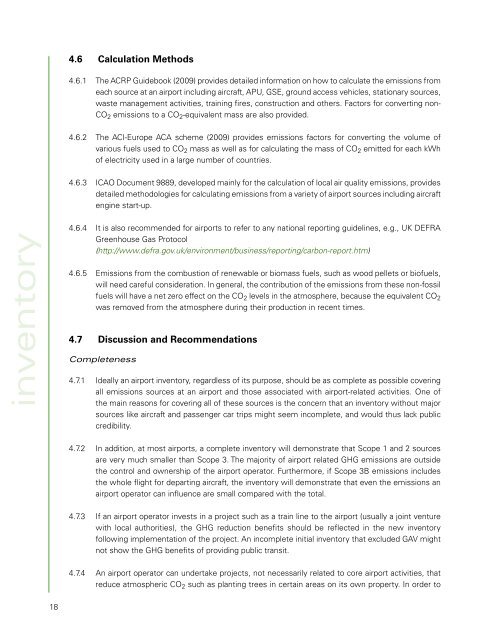Airport Greenhouse Gas Emissions Management - Zurich Airport
Airport Greenhouse Gas Emissions Management - Zurich Airport
Airport Greenhouse Gas Emissions Management - Zurich Airport
Create successful ePaper yourself
Turn your PDF publications into a flip-book with our unique Google optimized e-Paper software.
4.6 Calculation Methods<br />
4.6.1 The ACRP Guidebook (2009) provides detailed information on how to calculate the emissions from<br />
each source at an airport including aircraft, APU, GSE, ground access vehicles, stationary sources,<br />
waste management activities, training fires, construction and others. Factors for converting non-<br />
CO 2 emissions to a CO 2 -equivalent mass are also provided.<br />
4.6.2 The ACI-Europe ACA scheme (2009) provides emissions factors for converting the volume of<br />
various fuels used to CO 2 mass as well as for calculating the mass of CO 2 emitted for each kWh<br />
of electricity used in a large number of countries.<br />
4.6.3 ICAO Document 9889, developed mainly for the calculation of local air quality emissions, provides<br />
detailed methodologies for calculating emissions from a variety of airport sources including aircraft<br />
engine start-up.<br />
inventory<br />
4.6.4 It is also recommended for airports to refer to any national reporting guidelines, e.g., UK DEFRA<br />
<strong>Greenhouse</strong> <strong>Gas</strong> Protocol<br />
(http://www.defra.gov.uk/environment/business/reporting/carbon-report.htm)<br />
4.6.5 <strong>Emissions</strong> from the combustion of renewable or biomass fuels, such as wood pellets or biofuels,<br />
will need careful consideration. In general, the contribution of the emissions from these non-fossil<br />
fuels will have a net zero effect on the CO 2 levels in the atmosphere, because the equivalent CO 2<br />
was removed from the atmosphere during their production in recent times.<br />
4.7 Discussion and Recommendations<br />
Completeness<br />
4.7.1 Ideally an airport inventory, regardless of its purpose, should be as complete as possible covering<br />
all emissions sources at an airport and those associated with airport-related activities. One of<br />
the main reasons for covering all of these sources is the concern that an inventory without major<br />
sources like aircraft and passenger car trips might seem incomplete, and would thus lack public<br />
credibility.<br />
4.7.2 In addition, at most airports, a complete inventory will demonstrate that Scope 1 and 2 sources<br />
are very much smaller than Scope 3. The majority of airport related GHG emissions are outside<br />
the control and ownership of the airport operator. Furthermore, if Scope 3B emissions includes<br />
the whole flight for departing aircraft, the inventory will demonstrate that even the emissions an<br />
airport operator can influence are small compared with the total.<br />
4.7.3 If an airport operator invests in a project such as a train line to the airport (usually a joint venture<br />
with local authorities), the GHG reduction benefits should be reflected in the new inventory<br />
following implementation of the project. An incomplete initial inventory that excluded GAV might<br />
not show the GHG benefits of providing public transit.<br />
4.7.4 An airport operator can undertake projects, not necessarily related to core airport activities, that<br />
reduce atmospheric CO 2 such as planting trees in certain areas on its own property. In order to<br />
18

















